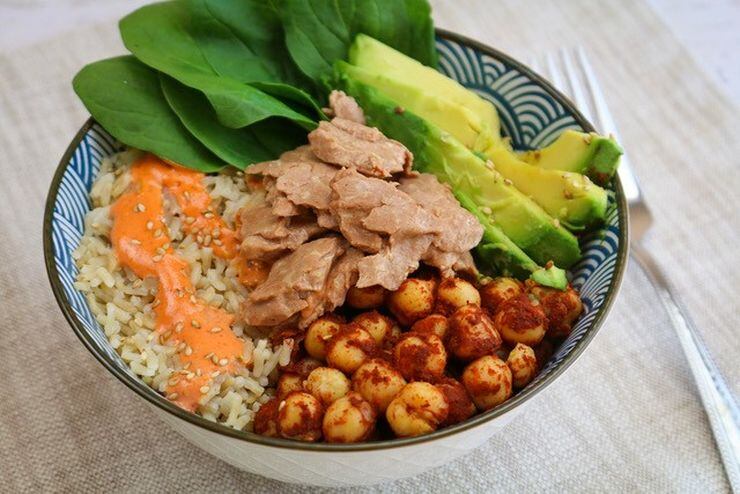Founded in 2013 as a spin off from UC San Diego, Triton Algae Innovations utilizes Chlamydomonas reinhardtii, a single-celled freshwater green algae species that can grow heterotrophically in fermentation tanks, with the ability to express multiple proteins found in plants and mammalian cells.
Triton is building a b2b business, and will "commence commercial-scale production of red and green algae this year," but also plans to road test its wares through a consumer launch (tuna) to show consumers what’s possible, said the firm: "Retail would be first, but discussions are also underway over potential foodservice pathways."
Triton has three Non GMO C. reinhardtii product streams it believes could have significant potential.
- Essential Green (for use in juices, snacks, smoothies, pasta, noodles, protein/energy bars or bites, breads, crackers etc) which comes with an FDA GRAS no questions letter). Triton recently announced a deal with China Touyun Tech Group Limited to scale up production in Asia.
- Essential Red (which has particular potential in plant-based meat/seafood alternatives). Triton is currently producing “hundreds of kilos” for sampling purposes, and has just struck a deal with a co-packer in the US to begin commercial scale production later this year. It is also putting together a GRAS determination.
- A white, neutral-flavored algae, which is attracting a lot of interest in meat alternatives and a wide range of other potential food applications from a nutritional enhancement perspective.
It has also developed engineered versions of C. reinhardtii that can produce mammalian proteins such as osteopontin (found in breastmilk), although this work is currently on the backburner as the startup focuses on its Non GMO protein platform.
How the algae will be listed on food labels is still to be determined, said director of corporate and regulatory affairs, Dave Schroeder: "We are currently working on this in the context of the relevant regulatory frameworks."
Chlamydomonas reinhardtii, a single-celled algae species, has the ability to express multiple proteins found in plants and mammalian cells including bovine and human osteopontin. Triton has developed a cost effective, scalable, heterotrophic production process for Chlamydomonas reinhardtii.
Plant-based seafood potential
To produce Essential Red, Triton uses UV light (a widely used technique in plant breeding) to stimulate its green algae to turn red and produce heme (which imparts color and flavor). While the UV alters the DNA of the algae, this is not classified as ‘genetic engineering’ and no genes from other species are introduced, said Schroeder.
"We evolve the strain in the same way that a plant exposed to the UV light of the sun would be evolved. At Triton we accelerate that process and apply high throughput selection methods to isolate the strains we want. The red strain is the exact same species as the green strain, except that it was selected by identifying a strain that no longer produces chlorophyll and that upregulates compounds found in the heme pathway known to provide meat-like properties.
"The heme pathway naturally exists in algae. Normally most of the pathway is shuttled to chlorophyll. When the cells no longer make chlorophyll, they are free to accumulate components of the heme pathway. There is no introduction of foreign genes into any of our strains that we intend to commercialize."
While heme can be extracted out of the algae cells via fractionation, Triton says it sees the most potential in using the whole algae ingredient (Essential Red), which contains 40-50% protein, minerals such as calcium and potassium, and carotenoids such as astaxanthin and beta carotene. The strain currently being commercialized includes short-chain omega-3 ALA, but other strains of chlamydomonas are under development that produce long-chain omega-3s such as DHA.
Essential Red could work well in sausages and burgers as part of the protein blend (its fat also helps improve mouthfeel in these products), but the key area of interest right now is plant-based seafood, particularly tuna, given the algae’s natural red hue and appealing nutritional profile, Miller Tran, PhD, Co-founder and VP of R&D, told FoodNavigator-USA.
“It’s not like beet juice color; it has unique properties in terms of how it behaves with plant proteins that make it very attractive. We’re planning to launch a tuna alternative with our red algae being one of the star ingredients.
“We really like what companies such as Good Catch have done, but we felt we could improve it from a flavor, texture, and appearance standpoint, so it looks more like what you’d expect from a tuna product.”
Tuna product will combine Triton’s red algae with plant-based proteins
While Triton had originally envisaged extracting the heme and selling that as a standalone ingredient to plant-based meat companies, it had become clear that the whole food ingredient had strong potential in alternative meat, he said.
“Why throw away the rest which is rich in proteins and omega 3s? Why not deliver two punches with one ingredient? So we harvest it [the biomass] spray dry it into a powder, and it can be stored at room temperature for a year.”
While Triton’s tuna product will combine its algae with plant proteins, “one of our goals ultimately is to have a 100% algae product,” said Tran.
Algae and protein production
Triton is not the first company to use algae as a protein production platform; blue/green algae spirulina is widely used in foods and supplements, while several companies have been working with chlorella (notably, Corbion has a tie up with Nestlé in this respect).
But Chlamydomonas reinhardtii - which has similar protein levels to chlorella and spirulina - has some distinct advantages, said Tran, noting that Triton can dial up and down various components within the algae by varying the growing conditions and by Non GM breeding techniques.
“It has a superior taste and a great nutritional profile, but a big difference is that the cell wall is glycoprotein, so the algae is fully digestible, whereas with chlorella, the cell wall is made from a different material [chitin] which is not digestible, and it’s harder to customize via breeding.
“We’ve also shown that we can produce this at scale and customize the nutritional profile, without using GMOs, by selecting different phenotypes using classical breeding as well as modifying the processing conditions.”

The plant-based seafood market is pretty small fry in dollar terms right now, but is poised to grow significantly in the next couple of years, predict the entrepreneurs behind a new wave of brands seeking to take plant-based tuna, shrimp, crab cakes, and fish burgers into mainstream retail and foodservice markets.
Good Catch (which recently opened a new plant and raised $32m in a Series B), now has products in thousands of grocery stores in the US, Canada and the UK and is gearing up for some big foodservice launches; New Wave Foods (which counts meat giant Tyson as an investor) has just raised $18m in a Series A; Nestlé has entered the market in Europe with a tuna alternative; and Impossible Foods has plant-based seafood products in the pipeline. Read more HERE.

